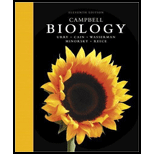
CAMPBELL BIOLOGY-W/MOD.MASTERBIOLOGY
11th Edition
ISBN: 9780134683461
Author: Urry
Publisher: PEARSON
expand_more
expand_more
format_list_bulleted
Concept explainers
Textbook Question
Chapter 25, Problem 5TYU
Which of the following steps has not yet been accomplished by scientists studying the origin of life?
- (A) synthesis of small RNA
polymers by ribozymes - (B) formation of molecular aggregates with selectively permeable membranes
(C) formation of protocells that use DNA to direct the
(D) abiotic synthesis of organic molecules
Expert Solution & Answer
Want to see the full answer?
Check out a sample textbook solution
Students have asked these similar questions
Green Algae, as a group, is actually paraphyletic with one subgroup more closely related to higher plants than the other. Which of the following green algae groups is more closely related to higher plants:
a. Charophyceans
b. Chlorophyceans
c. Rhodophyta
d. Xanthophyceans
A single-celled green algal genus that is motile with 2 flagella, has a cup shaped chloroplast, and an eyespot:
a. Volvox
b. Chlamydomonas
c. Euglena
d. Codium
A[n] ___ is produced by members of the Myxomycota when there is a lack of moisture.
a. plasmodiocarp
b. aethalium
c. sclerotium
d. plasmodium
Chapter 25 Solutions
CAMPBELL BIOLOGY-W/MOD.MASTERBIOLOGY
Ch. 25.1 - What hypothesis did Miller test in his classic...Ch. 25.1 - How would the appearance of protocells have...Ch. 25.1 - MAKE CONNECTIONS In changing from an "RNA world"...Ch. 25.2 - Describe an example from the fossil record that...Ch. 25.2 - WHAT IF? Your measurements indicate that a...Ch. 25.3 - The first appearance of free oxygen in the...Ch. 25.3 - What evidence supports the hypothesis that...Ch. 25.3 - WHAT IF? What would a fossil record of life today...Ch. 25.4 - Explain the consequences of plate tectonics for...Ch. 25.4 - What factors promote adaptive radiations?
Ch. 25.4 - Prob. 3CCCh. 25.5 - Explain how new body forms can originate by...Ch. 25.5 - Why is it likely that Hox genes have played a...Ch. 25.5 - MAKE CONNECTIONS Given that changes in morphology...Ch. 25.6 - How can the Darwinian concept of descent with...Ch. 25.6 - Prob. 2CCCh. 25 - Describe the roles that montmorillonite clay and...Ch. 25 - What are the challenges of estimating the ages of...Ch. 25 - What is the "Cambrian explosion," and why is it...Ch. 25 - Explain how the broad evolutionary changes seen in...Ch. 25 - How could changes in a Single gene or DNA region...Ch. 25 - Explain the reasoning behind the Statement...Ch. 25 - Level 1: Knowledge/Comprehension 1. Fossilized...Ch. 25 - The oxygen revolution changed Earth's environment...Ch. 25 - Prob. 3TYUCh. 25 - Prob. 4TYUCh. 25 - Which of the following steps has not yet been...Ch. 25 - Prob. 6TYUCh. 25 - Prob. 7TYUCh. 25 - EVOLUTION CONNECTION Describe how gene flow,...Ch. 25 - Prob. 9TYUCh. 25 - WRITE ABOUT A THEME: ORGANIZATION You have seen...Ch. 25 - Prob. 11TYU
Knowledge Booster
Learn more about
Need a deep-dive on the concept behind this application? Look no further. Learn more about this topic, biology and related others by exploring similar questions and additional content below.Similar questions
- Which of the following is not true about the life-cycle of Fucus. a. 8 eggs per oogonium b. 64 sperm per antheridium c. eggs are flagellated d. sperm are flagellatedarrow_forwardGreen Algae, as a group, is actually paraphyletic with one subgroup more closely related to higher plants than the other. Which of the following green algae groups is more closely related to higher plants: a. Charophyceans b. Chlorophyceans c. Rhodophyta d. Xanthophyceansarrow_forwardCertain toxic terpenoids in this group is thought to deter herbivory but may also have some anti-tumor activity? a. green algae b. brown algae c. red algae d. golden algae e. none of thesearrow_forward
- In the cellular slime molds, the most common phase is: a. plasmodium b. pseudoplasmodial c. single cells as myxamoebae d. moundingarrow_forwardWhich of the following descriptive terms does not describe Hydrodictyon? a. colonial b. nonmotile c. 1 large reticulated chloroplast in each cell d. all of these describe Hydrodictyonarrow_forwardWhich of the following does not apply to Chara? a. "stoneworts" b. isogamous c. calcified walls d. apical growth with an axis and branchesarrow_forward
arrow_back_ios
SEE MORE QUESTIONS
arrow_forward_ios
Recommended textbooks for you
 Biology (MindTap Course List)BiologyISBN:9781337392938Author:Eldra Solomon, Charles Martin, Diana W. Martin, Linda R. BergPublisher:Cengage Learning
Biology (MindTap Course List)BiologyISBN:9781337392938Author:Eldra Solomon, Charles Martin, Diana W. Martin, Linda R. BergPublisher:Cengage Learning Biology: The Dynamic Science (MindTap Course List)BiologyISBN:9781305389892Author:Peter J. Russell, Paul E. Hertz, Beverly McMillanPublisher:Cengage Learning
Biology: The Dynamic Science (MindTap Course List)BiologyISBN:9781305389892Author:Peter J. Russell, Paul E. Hertz, Beverly McMillanPublisher:Cengage Learning Concepts of BiologyBiologyISBN:9781938168116Author:Samantha Fowler, Rebecca Roush, James WisePublisher:OpenStax College
Concepts of BiologyBiologyISBN:9781938168116Author:Samantha Fowler, Rebecca Roush, James WisePublisher:OpenStax College
 Biology Today and Tomorrow without Physiology (Mi...BiologyISBN:9781305117396Author:Cecie Starr, Christine Evers, Lisa StarrPublisher:Cengage Learning
Biology Today and Tomorrow without Physiology (Mi...BiologyISBN:9781305117396Author:Cecie Starr, Christine Evers, Lisa StarrPublisher:Cengage Learning Human Biology (MindTap Course List)BiologyISBN:9781305112100Author:Cecie Starr, Beverly McMillanPublisher:Cengage Learning
Human Biology (MindTap Course List)BiologyISBN:9781305112100Author:Cecie Starr, Beverly McMillanPublisher:Cengage Learning

Biology (MindTap Course List)
Biology
ISBN:9781337392938
Author:Eldra Solomon, Charles Martin, Diana W. Martin, Linda R. Berg
Publisher:Cengage Learning

Biology: The Dynamic Science (MindTap Course List)
Biology
ISBN:9781305389892
Author:Peter J. Russell, Paul E. Hertz, Beverly McMillan
Publisher:Cengage Learning

Concepts of Biology
Biology
ISBN:9781938168116
Author:Samantha Fowler, Rebecca Roush, James Wise
Publisher:OpenStax College


Biology Today and Tomorrow without Physiology (Mi...
Biology
ISBN:9781305117396
Author:Cecie Starr, Christine Evers, Lisa Starr
Publisher:Cengage Learning

Human Biology (MindTap Course List)
Biology
ISBN:9781305112100
Author:Cecie Starr, Beverly McMillan
Publisher:Cengage Learning
The Evolution of Populations: Natural Selection, Genetic Drift, and Gene Flow; Author: Professor Dave Explains;https://www.youtube.com/watch?v=SRWXEMlI0_U;License: Standard YouTube License, CC-BY
The Evolution of Humans | Evolution | Biology | FuseSchool; Author: FuseSchool - Global Education;https://www.youtube.com/watch?v=Vf_dDp7drFg;License: Standard YouTube License, CC-BY